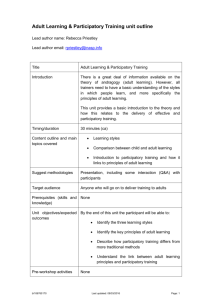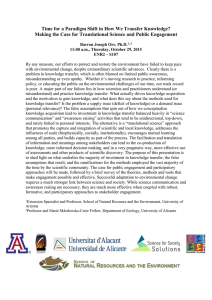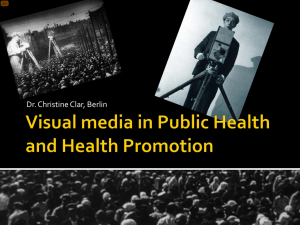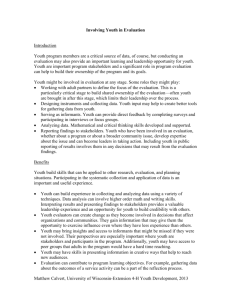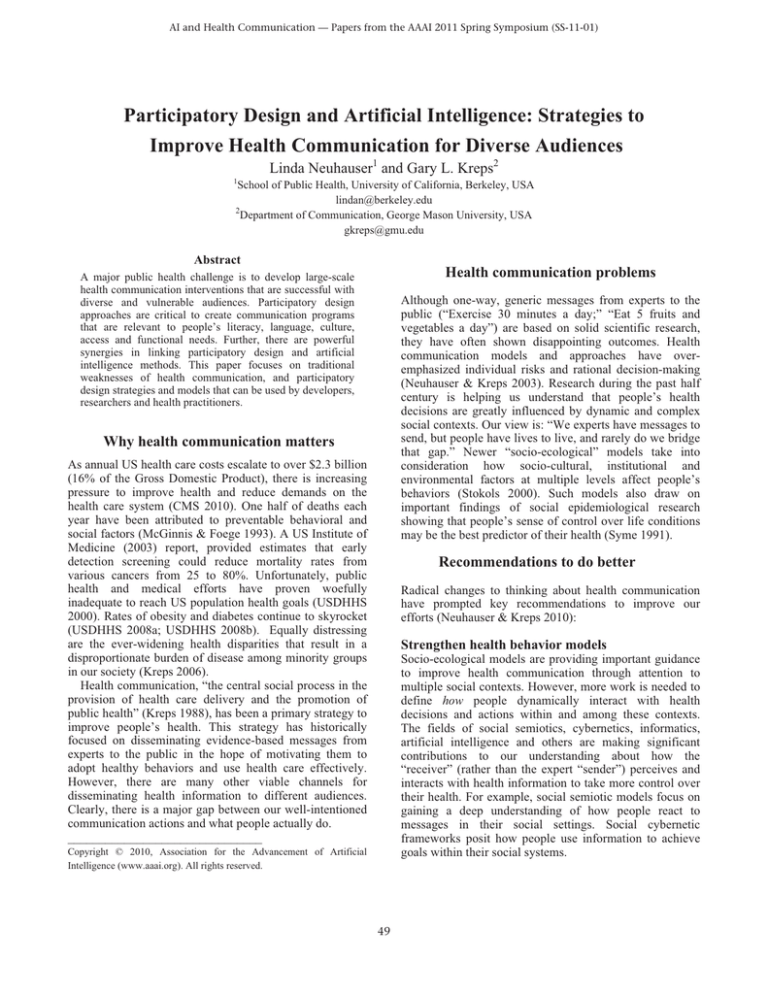
AI and Health Communication — Papers from the AAAI 2011 Spring Symposium (SS-11-01)
Participatory Design and Artificial Intelligence: Strategies to
Improve Health Communication for Diverse Audiences
Linda Neuhauser1 and Gary L. Kreps2
1
School of Public Health, University of California, Berkeley, USA
lindan@berkeley.edu
2
Department of Communication, George Mason University, USA
gkreps@gmu.edu
Abstract
Health communication problems
A major public health challenge is to develop large-scale
health communication interventions that are successful with
diverse and vulnerable audiences. Participatory design
approaches are critical to create communication programs
that are relevant to people’s literacy, language, culture,
access and functional needs. Further, there are powerful
synergies in linking participatory design and artificial
intelligence methods. This paper focuses on traditional
weaknesses of health communication, and participatory
design strategies and models that can be used by developers,
researchers and health practitioners.
Although one-way, generic messages from experts to the
public (“Exercise 30 minutes a day;” “Eat 5 fruits and
vegetables a day”) are based on solid scientific research,
they have often shown disappointing outcomes. Health
communication models and approaches have overemphasized individual risks and rational decision-making
(Neuhauser & Kreps 2003). Research during the past half
century is helping us understand that people’s health
decisions are greatly influenced by dynamic and complex
social contexts. Our view is: “We experts have messages to
send, but people have lives to live, and rarely do we bridge
that gap.” Newer “socio-ecological” models take into
consideration how socio-cultural, institutional and
environmental factors at multiple levels affect people’s
behaviors (Stokols 2000). Such models also draw on
important findings of social epidemiological research
showing that people’s sense of control over life conditions
may be the best predictor of their health (Syme 1991).
Why health communication matters
As annual US health care costs escalate to over $2.3 billion
(16% of the Gross Domestic Product), there is increasing
pressure to improve health and reduce demands on the
health care system (CMS 2010). One half of deaths each
year have been attributed to preventable behavioral and
social factors (McGinnis & Foege 1993). A US Institute of
Medicine (2003) report, provided estimates that early
detection screening could reduce mortality rates from
various cancers from 25 to 80%. Unfortunately, public
health and medical efforts have proven woefully
inadequate to reach US population health goals (USDHHS
2000). Rates of obesity and diabetes continue to skyrocket
(USDHHS 2008a; USDHHS 2008b). Equally distressing
are the ever-widening health disparities that result in a
disproportionate burden of disease among minority groups
in our society (Kreps 2006).
Health communication, “the central social process in the
provision of health care delivery and the promotion of
public health” (Kreps 1988), has been a primary strategy to
improve people’s health. This strategy has historically
focused on disseminating evidence-based messages from
experts to the public in the hope of motivating them to
adopt healthy behaviors and use health care effectively.
However, there are many other viable channels for
disseminating health information to different audiences.
Clearly, there is a major gap between our well-intentioned
communication actions and what people actually do.
_______________________________
Recommendations to do better
Radical changes to thinking about health communication
have prompted key recommendations to improve our
efforts (Neuhauser & Kreps 2010):
Strengthen health behavior models
Socio-ecological models are providing important guidance
to improve health communication through attention to
multiple social contexts. However, more work is needed to
define how people dynamically interact with health
decisions and actions within and among these contexts.
The fields of social semiotics, cybernetics, informatics,
artificial intelligence and others are making significant
contributions to our understanding about how the
“receiver” (rather than the expert “sender”) perceives and
interacts with health information to take more control over
their health. For example, social semiotic models focus on
gaining a deep understanding of how people react to
messages in their social settings. Social cybernetic
frameworks posit how people use information to achieve
goals within their social systems.
Copyright © 2010, Association for the Advancement of Artificial
Intelligence (www.aaai.org). All rights reserved.
49
Design communication that is more personal and
contextual
The promise of e-health communication
Given the ever-widening health disparities, generic health
communication has clearly failed to meet at-risk groups’
needs for information that is relevant to their literacy level,
language, culture, access and functional needs. For
example, although the average US adult is estimated to
read at an 8th grade level, most health information is
written at a 10th grade or college level. An estimated 90
million American adults lack the skills to understand health
communication they receive (Kutner, Greenberg & Baer
2005). Contextualizing information to people’s life
situations can help them better navigate the health care
system and find social support to change entrenched health
behaviors. Likewise, it’s essential to help people identify
specific steps to take action (such as how to customize a
personal exercise plan into their schedule).
The emergence of “e-health” communication—
communication that is mediated by the Internet or other
digital technologies—offers unprecedented opportunities to
overcome many of the weaknesses of traditional health
communication and extend more effective communication
to many people at low-cost. E-health features include the
capacity to craft communication to an individual’s specific
demographic and health characteristics or personal
information preferences (“mass customization,” or
“tailoring”). Computer-automated telephone, e-mail, or
SMS text reminders, online health communities, in-home
biometric devices, interactive health games, and an everincreasing array of new applications, are making it possible
to create highly personal, socially contextual and
interactive communication. If, as epidemiological research
suggests, “control” is the factor most predictive of people’s
health, e-health communication offers the most
opportunities for people to take that control.
Nearly three decades of e-health communication
research show overall positive outcomes among diverse
populations and across many health conditions (Neuhauser
& Kreps 2010; Neuhauser & Kreps 2003). However,
important challenges still threaten the potential of e-health
strategies to improve people’s health on a large scale and
reduce health disparities. Although Internet and other
digital media usage is growing rapidly, many people with
barriers related to literacy, language, disability, or income,
lack effective access. Further, the results of e-health
communication interventions show uneven outcomes.
When developers do not take advantage of the potential of
these new media to be deeply meaningful and useful to the
intended beneficiaries, the results are sometimes as
disappointing as they have been in the past.
Enhance the interactivity of communication
The classic approach of telling people what to do to
improve their health is often off-putting, disempowering
and ineffective (Neuhauser & Kreps 2003). Change is
“transactional”: people become aware of advice (get
screened for cancer), engage in a process to internalize a
message (this is important to me), understand the steps
make a change (navigate the health care system), weigh the
benefits (early detection) and costs (time, expense, fear of
findings) of adopting the behavior, make a decision, and
finally take action to carry out and maintain the behavior.
Therefore, people not only need health information that is
relevant to their personal situation and social contexts, but
also need support during the decision process and carrying
out a behavior change. Successful communication enables
and motivates people to “take control” of that process.
Increasingly, research shows that outcomes are better with
interactive, as compared to one-way, communication. The
more people participate in, and “drive” the communication
process the more likely they are to make healthy changes.
The power of participatory design
A major flaw in the development and implementation of
health communication approaches has been that the
intended beneficiaries are usually not closely involved. The
gap between “experts” and “the public” (or “sender” and
“receiver”) is often too great for our interventions to be
successful. Fortunately, we have learned a great deal about
how participatory design techniques can improve health
communication (Hesse & Shneiderman 2007).
Involvement of users in the design and implementation
of interventions has long been advocated by major public
health institutions (WHO 1981), but it has taken time for
this approach to become widespread. The participatory
design movement originated in the fields of engineering,
architecture and urban planning (see Neuhauser 2001).
Participatory design has been defined as “an approach to
the assessment, design and development of technological
and organizational systems that places a premium on the
active involvement of …potential or current users in design
and decision-making processes” (CPSR 2000).
Create communication with personal impact and
population reach
The goal of public health is to improve health on a largescale. Traditionally, the most effective health
communication approaches have been those that are
interpersonal—for example face-to-face counseling
between patients and physicians. However, interpersonal
communication is also expensive and increasingly difficult
to accommodate in today’s health care system. Mass media
approaches (brochures, TV, radio, etc.) are less costly and
have broader reach, but often show weak health effects.
When mass media communication is designed to be more
relevant to people’s needs, outcomes are improved
(Neuhauser et al. 2009). E-health communication is a
revolutionary development and is thought to have the
greatest overall potential to improve the outcomes of health
communication at a population level by combining
interpersonal and digitally mediated communication.
50
statewide distribution with SPD beneficiaries and multiple
state and community stakeholders; 5) guidebook adaptation
into 13 languages; and 6) distribution to beneficiaries.
The communication intervention was evaluated with
pre-post telephone surveys, focus groups and interviews
with beneficiaries and providers and through a
randomized-controlled trial with beneficiaries in three
counties (Neuhauser et al. 2009; Kurtovich et al. 2010)
Studies documented the complexity of the participatory
techniques and SPD beneficiaries’ and providers’
significant contributions to improving all aspects of the
guidebook’s content, format and usability. The resulting
resource was awarded the Institute for Healthcare
Advancement’s 2008 first place Health Literacy award for
Published Materials. Quantitative results showed marked
improvements in beneficiaries’ satisfaction, knowledge
gains, and capacities to make health care choices.
During the past two decades, “user-centered” design
processes have become central to the design of computing
systems and informatics (Schuler & Namioka 1993), but
are still far from the norm in health communication.
Participatory design, artificial intelligence and
cybernetics
McCarthy (2010) defines artificial intelligence (AI) as “the
science and engineering of intelligent machines, especially
computer programs” and as the “computational part of the
ability to achieve goals in the world.” From its inception in
the mid-1950s, AI has emphasized participatory design to
simulate capacities of human intelligence, and to ensure
that people can effectively use the machines and their
applications (Gil 1989; Russell & Norvig 2009). The field
of AI is synergistic with that of cybernetics: AI focuses on
design and implementation of machines to accomplish
goals; cybernetics focuses on describing the regulation of
technical, social and other systems towards goals (see:
Pangaro 2010; Winograd & Flores 1986; Wiener 1948).
In both fields, the use of participatory design techniques
is highly sophisticated and can be a rich source of guidance
for developing intelligent interactive health communication
programs. Likewise, public health research can inform AI
developers and cyberneticians about fine distinctions
among sub-groups in society who could benefit from better
functional access to computing systems and their adoption.
CrohnologyMD
Crohn’s is an auto-immune disease that causes serious
gastro-intestinal and other problems that are extremely
hard to accurately diagnose and clinically manage. The
ChronologyMD project, initiated in 2010 with funding
from the Robert Wood Johnson Foundation, is a
partnership of the Healthy Communities Foundation, HRA,
and the University of California, San Francisco. The
project is using participatory design and AI methods to
understand more specifically how patients experience
Crohn’s on a daily basis via “observations of daily living,”
(“ODLs”), what clinicians need to know from patients, and
how to create a shared communication system for better
decision-making. Methods include 1) focus groups and indepth interviews with patients and with clinicians to define
key knowledge variables that are personally and clinically
relevant; 2) AI methods to create decision algorithms and
human-computer interfaces that capture and display
important data useful to patients at home and to clinicians
in medical settings; 3) iterative usability testing with
patients and clinicians; and 4) iterative observations of the
system in clinical settings. Results are expected in 2012.
Examples of participatory design in health
communication
The following examples illustrate two projects that
incorporate principles of participatory design, AI, and
cybernetics to create more effective health communication
programs by and for diverse, underserved populations.
Mass media materials for Medicaid beneficiaries
The Medi-Cal Access Project began in 2006 to address the
problem that many of the million seniors and people with
disabilities (SPD) on Medicaid in California had poor
understanding of how to choose and navigate health care
systems. Available materials were written at a graduate
school level. The Health Research for Action (HRA) center
at the School of Public Health, University of California,
Berkeley, used a participatory process with SPD
beneficiaries to co-design a guidebook with them (see
Neuhauser et al. 2009 for a detailed description).
Participatory methods included: 1) establishment of a
steering committee of diverse SPD beneficiaries, service
providers, policy-makers and researchers; 2) focus groups
and in-depth interviews with SPD beneficiaries and service
providers to elicit key communication issues and concerns;
3) initial drafting by HRA staff of the guidebook, using
“plain language” principles; 4) five iterative rounds of
usability testing and focus groups to test prototype content
(including readability testing to assure that content did not
exceed a 6-7th grade level); 4) concurrent planning of
Discussion and Lessons Learned
Participatory design techniques have emerged as a critical
way to overcome the weaknesses of traditional health
communication approaches. Such techniques enable
developers and users to co-create communication that is
highly relevant to people’s personal and social contexts,
and that is motivating and actionable. Although these
techniques are not yet widespread, two decades of research
shows positive outcomes from this approach. Combining
participatory design, AI methods, and cybernetic guidance
is an especially promising strategy to improve health
communication for diverse and vulnerable populations.
Achieving this vision is challenging: more research is
needed to refine participatory design techniques,
demonstrate their added value, and promote their adoption
among developers, researchers, practitioners and funders.
51
References
Neuhauser, L. (2001). Participatory design for better interactive
health communication: A statewide model in the USA. Electronic
Journal of Communication 11, nos. 3 and 4.
Centers for Medicare and Medicaid Services (CMS). (2010).
National Health Care Expenditures Data. Report. CMS, Office of
the Actuary, National Health Statistics Group.
Neuhauser, L., and G. Kreps. (2003). Rethinking communication
in the e-health era. Journal of Health Psychology, 8: 722.
Colditz, G., DeJong, W., Hunter, D., Trichopoulos, D., & Willett,
W. (1996). Harvard report on cancer prevention: Causes of
human cancer. Cancer Causes and Control, 1(7), 1569–1574.
Neuhauser, L., & Kreps, G. (2010). Ehealth communication and
behavior change: promise and performance. Journal of Social
Semiotics, 20:1,9-27.
CPSR (Computer Professionals for Social Responsibility).
(2000). Participatory design. Accessed January 15, 2011 from:
Internet site http://cpsr.org/issues/pd.
Neuhauser, L., Rothschild, B., Graham, C., Ivey, S., & Konishi,
S. (2009). Participatory design of mass health communication in
three languages for seniors and people with disabilities on
Medicaid. American Journal of Public Health, 99:2188-2195.
Gil, K. (1989). Reflections on participatory design. AI & Society,
3: 297-314.
Pangaro, P. Getting started guide to cybernetics. Accessed online
November 2010 at: http://www.pangaro.com/published/cybermacmillan.html
Hesse, B.W., and B. Shneiderman (2007). eHealth research from
the user’s perspective. American Journal of Preventive Medicine,
32: S97103.
Russell, S. and Norvig, P. (2009). Artificial Intelligence: A
Modern Approach. 3rd Edition. Prentice-Hall
Institute of Medicine. (2003). Fulfilling the potential of cancer
prevention and early detection. Washington, DC: National
Academies Press.
Stokals, D. (2000). The social ecological paradigm of wellness
promotion. In M. S. Jamner & D. Stokals (Eds.), Promoting
human wellness: New Frontiers for research, practice, and policy
(pp. 21–37). Berkeley, Los Angeles, London: University of
California Press.
Kreps, G.L. (2006). Communication and racial inequities in
health care. American Behavioral Scientist, 49(6), 760-774.
Kreps, G. L. (1988). The pervasive role of information in health
care: Implications for health communication policy. In J.
Anderson (Ed.), Communication yearbook (pp. 238–276).
Newbury Park, CA: Sage.
Schuler, D. & Namioka, A. (Eds.). (1993). Participatory design:
Principles and practices. New Jersey: Lawrence Erlbaum
Associates.
Syme SL. (1991). Control and health: A personal perspective.
Advances 7: 16-27.
Kreuter, M., Farrell, D., Olevitch, L., & Brennan, L. (2000).
Tailoring Health Messages. Mahwah, NJ: Lawrence Erlbaum
Associates.
US Department of Health and Human Services. (2000). Healthy
People 2010: Conference edition, Vols 1 and 2. Washington, DC:
US Government Printing Office.
Kurtovich, E., Ivey, S. L., Neuhauser, L., Graham, C.,
Constantine, W. and Barkan, H. (2010), A Multilingual Mass
Communication Intervention for Seniors and People with
Disabilities on Medicaid: A Randomized Controlled Trial. Health
Services
Research,
45: 397–417.
doi: 10.1111/j.14756773.2009.01073.x
US Department of Health and Human Services. (2008a). Progress
review: Nutrition and overweight. Washington, DC: US
Government Printing Office.
US Department of Health and Human Services. (2008b).
Progress review: Diabetes. Washington, DC: US Government
Printing Office.
Kutner, M., E. Greenberg, and J. Baer (2005). National
Assessment of Adult Literacy (NAAL): A first look at the literacy
of America’s adults in the 21st Century. Washington, DC: US
Department of Education, Institute of Education Sciences,
National Center for Education Statistics.
Wiener, N. (1948). Cybernetics, or control and communication in
the animal and the machine. Cambridge, Massachusetts: The
Technology Press; New York: John Wiley & Sons, Inc.
McCarthy, J. “What is artificial intelligence?” Computer Science
Department, Stanford University. Accessed online November
2010
from:
http://wwwformal.stanford.edu/jmc/whatisai/whatisai.html
World Health Organization. (1954). First meeting of the Expert
Committee on the Health Education of the Public.Technical
Report Series No. 89. World Health Organization, Geneva.
Winograd, T. and Flores, F. (1986). Understanding Computers
And Cognition: A New Foundation for Design. Norwood, New
Jersey: Ablex Publishing Corporation.
McGinnis, J. M., & Foege, W. H. (1993). Actual causes of death
in the United States. Journal of the American Medical
Association, 270(18), 2207–2211.
52


